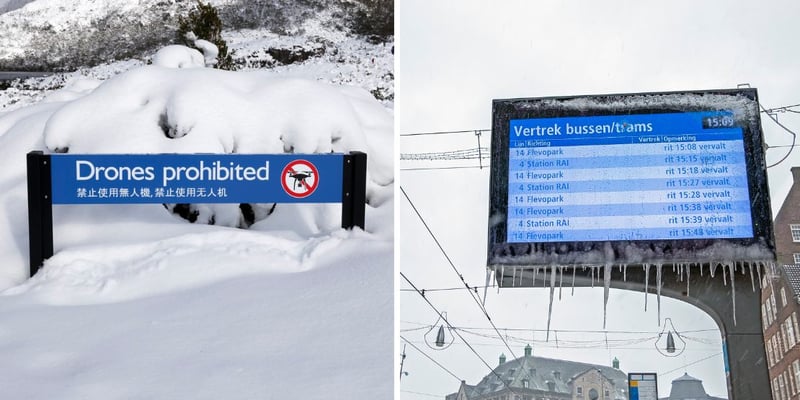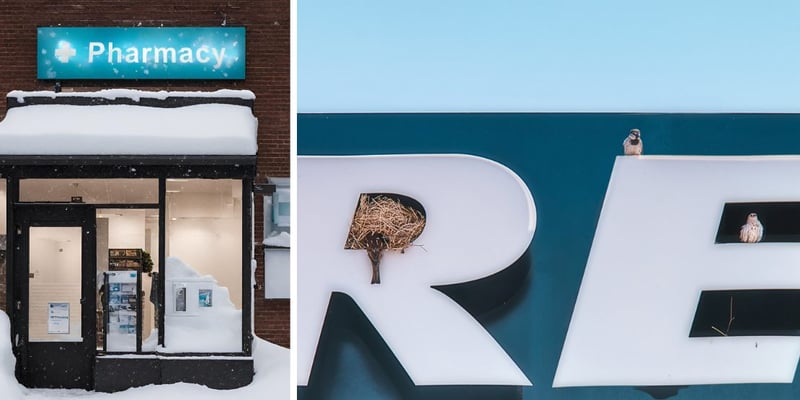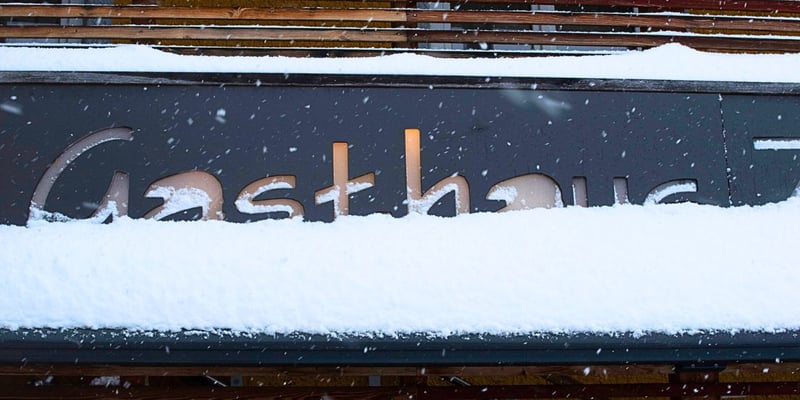Preparing Your Outdoor Business Signage for the Cold, Dark Months
As winter draws near, businesses brace themselves for the inevitable challenges brought by icy roads, extended nights, and chilling winds. Yet, often overlooked is the impact of winter on exterior commercial lighting and signs. In this guide, we delve into the importance of winter preparedness for your signage, understanding potential hazards, and implementing strategies to protect your brand's beacon.
Types of Winter Damage on Outdoor Business Signage:
Winter damage to your outdoor business signage can come from a wide array of natural and man-made sources. Watch out for these common causes of damage:
Temperature Fluctuations:
Freeze-Thaw Cycle: When water seeps into small cracks and crevices, the water freezes and expands, widening these cracks. When it warms up, the ice melts, allowing more water to enter. This continuous cycle can cause significant structural damage over time to signage, lighting fixtures and more.
Ice and Snow Accumulation:
Weight: Heavy snow and ice can accumulate on signage and light fixtures, stressing the structures and potentially causing them to bend, break, or fall.
Obstruction: Accumulated snow and ice can cover the signage, rendering it unreadable or hindering its visibility.
Icicles: These can form on the edges of signs or lights and can be a potential hazard if they fall.

Wind Damage:
Strong winter winds can exert force on signs, especially larger ones. This can lead to bending, cracking, misalignment, or even tearing signs from their mountings. Wind can also blow abrasive particles like sand and small pebbles against the signs, causing premature wear and scratches.
Water Damage:
Melting snow and ice can lead to water pooling around the base of freestanding signs, resulting in corrosion which can compromise the structural integrity of the sign. Water penetration into exterior commercial lighting fixtures can short-circuit them or reduce their lifespan.
UV Damage:
While we might associate UV damage more with summer, snowy landscapes can reflect a significant amount of UV radiation, potentially causing fading or degradation to the sign's materials and colors over time.
Electrical Issues:
Cold temperatures and moisture can stress and or short-circuit the wiring and electrical components of an LED sign or light fixtures, leading to temporary outages or permanent damage.
Material Brittleness:
Certain materials become more brittle in cold temperatures. Thin, low-quality plastic or acrylic signs, for instance, might crack or shatter more easily when subjected to impact in cold weather.
Wildlife Interference:
In seeking shelter from the cold, small animals or birds might nest or hide behind signage or within light fixtures, potentially causing damage or fire hazards.

Physical Impact:
Snowplows, vehicles, or even people might accidentally knock into outdoor business signage, especially during reduced visibility conditions or slippery surfaces. Falling tree branches, weighted by snow or broken by ice, can crash into and damage signs or lights.
Salt and Chemical Damage:
Many places use salt or other chemicals to melt ice on roads and pavements. When splashed onto signs and lighting fixtures, they can cause corrosion, especially on exposed metal parts.
Proactive Measures for Winter Sign Maintenance and Protection
Proactive steps can mitigate many of the issues faced by outdoor business signage. Here’s a roadmap to protect and prolong the life of your sign during the chilliest months:
Regular Inspections and Maintenance
- Schedule periodic checks before and during winter to identify potential vulnerabilities.
- Seal any visible cracks or gaps to prevent water infiltration and the subsequent freeze-thaw damage.
Strengthening and Reinforcement:
- Replace or reinforce sign mountings and structures, ensuring they're sturdy enough to withstand added weight from snow and strong winter winds.
- Use wind-resistant materials or add supportive struts to larger signs and exterior commercial lighting.
Snow and Ice Removal:
- Gently remove accumulated snow from signage surfaces. Utilize soft-bristled brushes to prevent scratching.
- Consider installing sign heaters or heat tapes for signs in particularly cold areas to reduce ice formation.
Waterproofing and Draining:
- Ensure proper drainage around freestanding signs to prevent water accumulation at the base.
- Waterproof electrical components to prevent short-circuits and moisture-induced malfunctions.
UV-Protective Coatings:
- Apply UV-resistant coatings or laminates to protect sign colors and materials from reflective UV damage.
Inspect Lighting
- Check your sign’s lighting to ensure there are no dead bulbs that would impact your sign’s visibility and property’s appearance in the dark, winter months
- Additionally, check other exterior commercial lighting sources to ensure walkways are bright and an cover sufficient area to guide pedestrians coming to or from your establishment
Electrical Precautions:
- Regularly check the wiring of illuminated LED signs and lighting fixtures. Consider upgrading to weather-resistant wiring.
- Install GFCI (Ground Fault Circuit Interrupter) outlets for outdoor signs to prevent electrical hazards.
Material Considerations:
- Choose materials that remain durable during cold temperatures. If using plastics or acrylics, ensure they're of a grade resistant to winter brittleness.
Wildlife Deterrence:
- Install mesh or screens behind or around signs to prevent animals from nesting.
- Periodically check for any signs of wildlife interference.
Physical Barriers:
- Set up protective barriers or bollards around vulnerable signs to protect from snow plows, vehicles, or pedestrian impacts.
- Install video cameras that can record who or what is responsible for any damage, which will be important for insurance companies.
Rinse and Protect Against Corrosives:
- Routinely clean signs to remove salt and chemical residues, preventing corrosion.
- Apply anti-corrosion coatings, especially to metal components, for added protection.
By incorporating these preventive measures, sign owners can effectively safeguard their outdoor business signage, ensuring visibility and durability throughout the winter season. Remember, a well-maintained sign not only portrays professionalism, but also serves as proof of that business's attention to detail and commitment to excellence.

Work With Experts to Protect Your Outdoor Business Signage
Properly winter proofing your signs and lighting fixtures is the best way to protect your investment. That’s why companies often prefer to hire a specialized maintenance team for a thorough inspection and servicing. The expert technicians at Flexlume are trusted by businesses across the country, carrying a reputation of excellence for over 115 years. Speak with the team today to see how we can simplify and super charge your next signage or exterior commercial lighting project.

